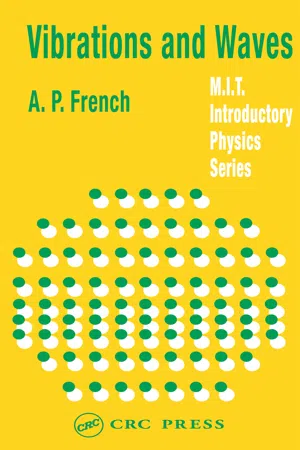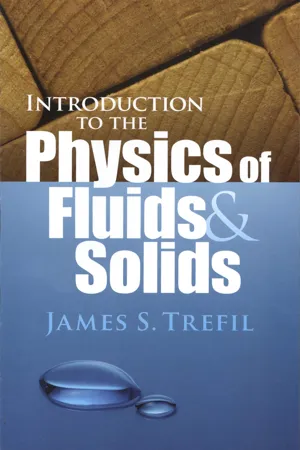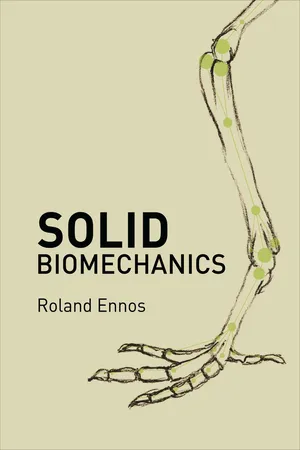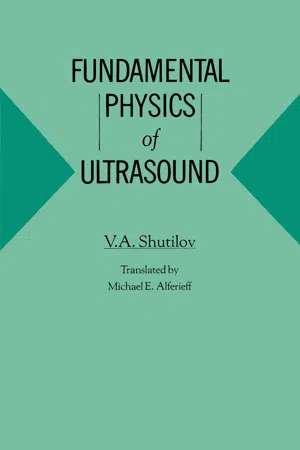Physics
Hooke's Law
Hooke's Law states that the force needed to extend or compress a spring by some distance is proportional to that distance. Mathematically, it is expressed as F = kx, where F is the force, k is the spring constant, and x is the displacement. This law is fundamental in understanding the behavior of elastic materials and is widely used in engineering and physics.
Written by Perlego with AI-assistance
Related key terms
Related key terms
1 of 4
Related key terms
1 of 3
5 Key excerpts on "Hooke's Law"
- eBook - ePub
Newtonian Dynamics
An Introduction
- Richard Fitzpatrick(Author)
- 2021(Publication Date)
- CRC Press(Publisher)
x . The extension of the spring is the difference between its actual length and its natural length (i.e., its length when it is exerting no force).The force acts parallel to the axis of the spring. In fact, Hooke’s law only holds if the extension of the spring is sufficiently small. If the extension becomes too large then the spring deforms permanently, or even breaks. Such behavior lies beyond the scope of Hooke’s law.Figure 4.1 illustrates how we might use Hooke’s law to quantify the force that we exert on a body of mass m when we pull on the handle of a spring attached to it. The magnitude, f, of the force is proportional to the extension of the spring; twice the extension means twice the force. As shown, the direction of the force is toward the spring, parallel to its axis (assuming that the extension is positive). The magnitude of the force can be quantified in terms of the critical extension required to impart a unit acceleration (i.e.,1) to a body of unit mass (i.e.,m/s21 kg). According to Equation (4.4), the force corresponding to this extension is 1N. Thus, if the critical extension corresponds to a force of1 Nthen half the critical extension corresponds to a force of0.5 N, and so on. In this manner, we can quantify both the direction and magnitude of the force that we exert, by means of a spring, on a given body.Figure 4.1Hooke’s lawSuppose that we apply two forces, f1 and f2 (say), acting in different directions, to a body of mass m by means of two springs. As illustrated in Figure 4.2 , it is a matter of experience that the body accelerates as if it were subject to a single force, f, that is the vector sum of the individual forces, f1 and f2 . Assuming that this is a general result, it follows that the force, f - eBook - ePub
- A.P. French(Author)
- 2017(Publication Date)
- CRC Press(Publisher)
3The free vibrations of physical systemsIN MAKING THE STATEMENT quoted opposite about the elastic properties of objects, Robert Hooke rather overstated the case. The restoring forces in any actual physical system are only approximately linear functions of displacement, as we noted near the beginning of Chapter 1 . Nevertheless, it is remarkable that a vast variety of deformations of physical systems, involving stretching, compressing, bending, or twisting (or combinations of all of these) result in restoring forces proportional to displacement and hence lead to simple harmonic vibration (or a superposition of harmonic vibrations). In this chapter we shall consider a number of examples of such motions, with particular emphasis on the way in which we can relate the kinematic features of the motion to properties that can often be found by purely static measurement. We shall begin with a closer look at the system that forms a prototype for so many oscillatory problems—a mass undergoing one-dimensional oscillations under the type of restoring force postulated by Hooke. Much of the discussion in the next section will probably be familiar ground, but it is important to be quite certain of it before proceeding further.The Basic Mass-Spring Problem
In our first reference to this type of system in Chapter 1 , we characterized it as consisting of a single object of mass m acted on by a spring [Fig. 3-1 (a) ] or some equivalent device, e.g., a thin wire [Fig. 3-1(b) ], that supplies a restoring force equal to some constant k times the displacement from equilibrium. This identifies, in terms of a system of a particularly simple kind, the two features that are essential to the establishment of oscillatory motions:Fig. 3-1 (a ) Mass-spring system . (b ) Mass-wire system - eBook - ePub
- James S. Trefil(Author)
- 2012(Publication Date)
- Dover Publications(Publisher)
There is no reason to expect, a priori, any particular kind of behavior. For example, if we imagined that the internal forces between the atoms in a solid could be represented by springs, then we might expect that the deformation would be proportional to the force applied. Such a solid is called an elastic solid, and will occupy most of our attention. We could also imagine that the forces between the atoms were such that they allowed no motion of the atoms unless the external force were strong enough to overcome them. In this case, there would be no deformation for small forces, and large deformations for large forces when, presumably, the material would fracture. Between these two extremes, one could imagine many different kinds of solids, and, indeed, there is an entire field of study called rheology, which is devoted to the study of the way in which materials react to forces applied to them. For our purposes, however, we shall consider only the simple case of an elastic solid. To fix in our mind exactly what is meant by such a solid, imagine a thin wire of length l from which weights can be hung. For a given weight W, the wire will stretch a distance Δ l. It is an experimental fact that for most materials, the amount of stretching is proportional to the force, so that This experimental finding is called Hooke’s law, and the constant of proportionality E is called Young’s modulus. There is an interesting analogy between this law and a result which we found true for fluids in Chapter 1. The reader will recall that in order to specify the physical situation involving a fluid, it was necessary to say what kind of fluid we were considering—i.e. to specify an equation of state. Similarly, in this case, it is necessary to specify the type of solid being considered - eBook - ePub
- Roland Ennos(Author)
- 2011(Publication Date)
- Princeton University Press(Publisher)
PART 1
Understanding Elasticity
Passage contains an image
CHAPTER 1
The Properties of Materials
FORCES: DYNAMICS AND STATICS
We all have some intuitive idea about the mechanics of the world around us, an idea built up largely from our own experience. However, a proper scientific understanding of mechanics has taken centuries to achieve. Isaac Newton was of course the founder of the science of mechanics; he was the first to describe and understand the ways in which moving bodies behave.Introducing the concepts of inertia and force, he showed that the behavior of moving bodies could be summed up in three laws of motion. 1) The law of inertia: An object in motion will remain in motion unless acted upon by a net force. The inertia of an object is its reluctance to change its motion. 2) The law of acceleration: The acceleration of a body is equal to the force applied to it divided by its mass, as summarized in the equationwhere F is the force; m , the mass; and a , the acceleration.3) The law of reciprocal action: To every action there is an equal and opposite reaction. If one body pushes on another with a given force, the other will push back with the same force in the opposite direction.To summarize with a simple example: if I give a push to a ball that is initially at rest (fig. 1.1a ), it will accelerate in that direction at a rate proportional to the force and inversely proportional to its mass. The great step forward in Newton’s scheme was that, together with the inverse square law of gravity, it showed that the force that keeps us down on earth is one and the same with the force that directs the motion of the planets.All this is a great help in understanding dynamic situations, such as billiard balls colliding, guns firing bullets, planets circling the sun, or frogs jumping. Unfortunately it is much less useful when it comes to examining what is happening in a range of no-less-common everyday situations. What is happening when a book is lying on a desk, when a light bulb is hanging from the ceiling, or when I am trying to pull a tree over? (See fig. 1.1b. ) In all of these static situations, it is clear that there is no acceleration (at least until the tree does fall over), so the table or rope must be resisting gravity and the tree must be resisting the forces I am putting on it with equal and opposite reactions. But how do objects supply that reaction, seeing as they have no force-producing muscles to do so? The answer lies within the materials - eBook - ePub
- Shutilov(Author)
- 2020(Publication Date)
- CRC Press(Publisher)
The generalized Hooke’s law can then be formulated as follows: the components of the stress at a given point of the body are linear and homogeneous functions of all components of the strain, i.e. , σ 1 = c 1 1 ϵ 1 + c 1 2 ϵ 2 + c 13 ϵ 3 + c 14 ϵ 4 + c 15 ϵ 5 + c 1 6 ϵ 6 ; σ 2 = c 21 ϵ 1 + c 22 ϵ 2 + c 23 ϵ 3 + c 24 ϵ 4 + c 25 ϵ 5 + c 2 6 ϵ 6 ; σ 3 = c 31 ϵ 1 + c 32 ϵ 2[--. =PLGO-SEPARATOR=--]+ c 33 ϵ 3 + c 34 ϵ 4 + c 35 ϵ 5 + c 36 ϵ 6 ; σ 4 = c 41 ϵ 1 + c 42 ϵ 2 + c 43 ϵ 3 + c 44 ϵ 4 + c 45 ϵ 5 + c 46 ϵ 6 ; σ 5 = c 51 ϵ 1 + c 52 ϵ 2 + c 53 ϵ 3 + c 54 ϵ 4 + c 55 ϵ 5 +[-. -=PLGO-SEPARATOR=--]c 56 ϵ 6 ; σ 6 = c 61 ϵ 1 + c 62 ϵ 2 + c 63 ϵ 3 + c 64 ϵ 4 + c 65 ϵ 5 + c 66 ϵ 6 ; (I.13a) or, in general (matrix) form, σ n = c n m ϵ m, n, m = 1, 2, 3, 4, 5, 6 (I.13b) where summation over the repeated (dummy) index (the row index) is implied. In tensor form, when two indices must be retained for the components of the stresses and strains (as, for example, in the equation of motion (I.11)), the generalized Hooke’s law will have the form: σ i k = c iklj ϵ i j, (I.13c) The coefficients of proportionality c nm are called the linear elastic moduli or stiffness constants. Their dimensions are the same as the dimensions of stress; the 36 quantities c nm form a tensor of rank 4, called the elastic modulus tensor. In the theory of elasticity, it is shown 6, 7 that this tensor is symmetric, i.e. , c nm = c nm (c ikjl = c jlki), so that it contains 21 independent constants and has the. form c n m = [ c 11 c 12 c 13 c 14 c 15 c 16 c 12 c 22 c 23 c 24 c 25 c 26 c 13 c 32 c 33 c 34 c 35 c 36 c 14 c 42 c 43 c 44 c 45 c 46 c 15 c 52 c 53 c 54 c 55 c 56 c 16 c 62 c 63 c 64 c 65 c 66 ]. In this form, the. tensor c nm describes the elasticity of a medium without symmetry. The existence of symmetry reduces the total number of nonzero elastic moduli and the number of independent moduli. Table 1 shows the matrices of the elastic moduli for different crystallographic systems
Index pages curate the most relevant extracts from our library of academic textbooks. They’ve been created using an in-house natural language model (NLM), each adding context and meaning to key research topics.
Explore more topic indexes
Explore more topic indexes
1 of 6
Explore more topic indexes
1 of 4




